

 The Accurate Reloading Forums
The Accurate Reloading Forums  THE ACCURATE RELOADING.COM FORUMS
THE ACCURATE RELOADING.COM FORUMS  Guns, Politics, Gunsmithing & Reloading
Guns, Politics, Gunsmithing & Reloading  Gunsmithing
Gunsmithing  English Walnut Rifle Blanks
English Walnut Rifle BlanksGo  | New  | Find  | Notify  | Tools  | Reply  |  |
One of Us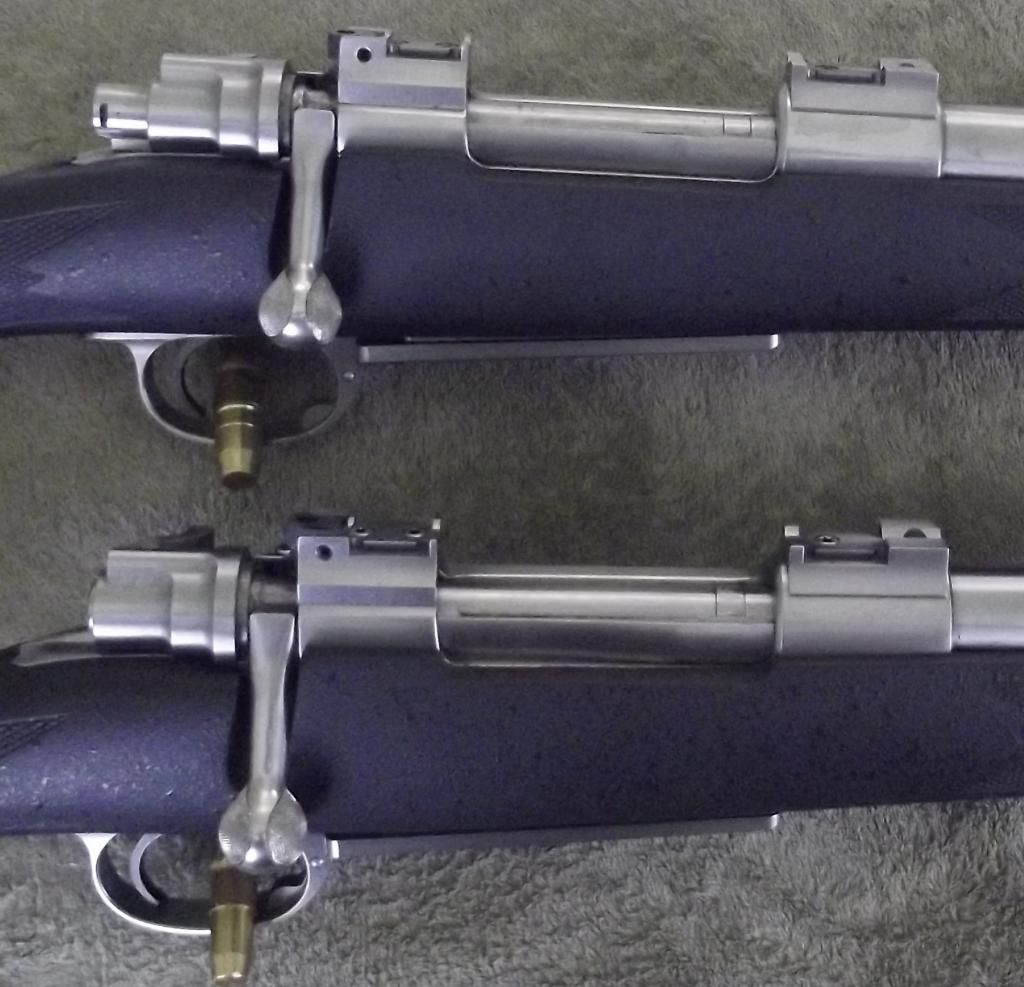 |
I need your comments regarding these two rifle blanks; Is the grain flow correct and sufficiently strong for use as the basis of a 50 caliber rifle? 1st stock blank – English walnut: 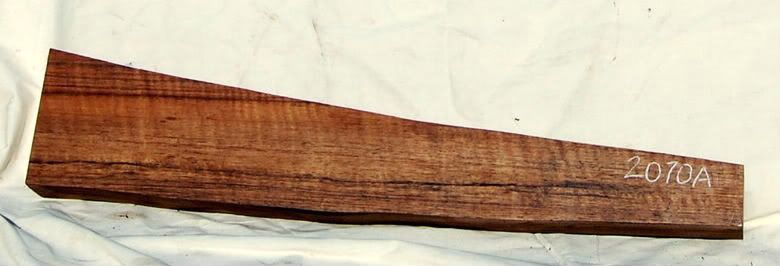  2nd stock blank – English walnut: 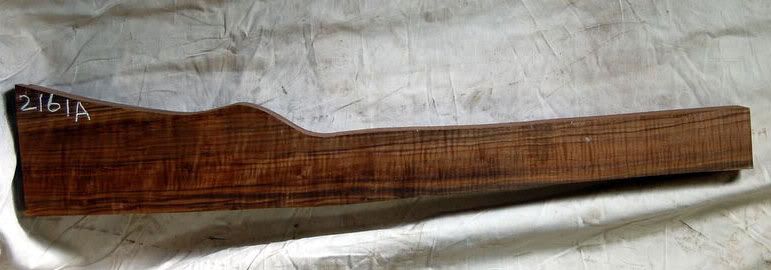 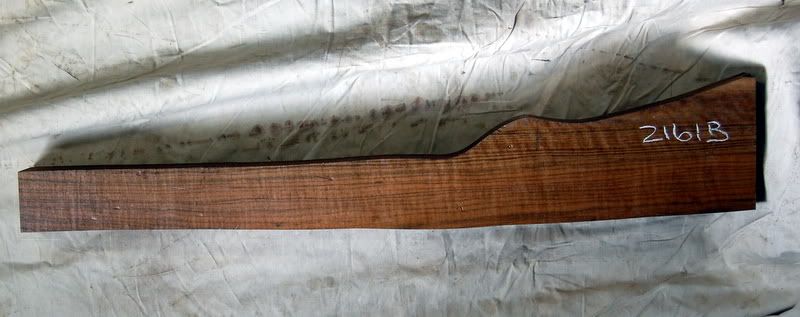 Thanks, Jim "Life's hard; it's harder if you're stupid" John Wayne | ||
|
| Moderator |
yep .. top pics are "upside down" .. i would probably buy either and use as a boomer stock opinions vary band of bubbas and STC hunting Club Information on Ammoguide about the416AR, 458AR, 470AR, 500AR What is an AR round? Case Drawings 416-458-470AR and 500AR. 476AR, http://www.weaponsmith.com | |||
|
| One of Us |
There are better out there----grain flow is not the best I would pass. | |||
|
one of us |
They both have musket style grain flow. If you cut your stock from the "middle" of the blank the grain will cut across the grip, which is never good. If the blanks are big enough you can tip your pattern to get better grain flow. But I don't believe either of these blanks will have the perfect grain flow that you look for in a big-bore stock. Having the grain run from the toe of the stock, through the grip and right out through the forend will give you the strongest stock. If you can't have it run through the pattern from one end to the other, then you at the very least want it to run from the toe through the grip. If the grain runs out through the top of the forend the stock will not be weakened too much, and will be less likely to warp in the upward direction. Jason "You're not hard-core, unless you live hard-core." _______________________ Hunting in Africa is an adventure. The number of variables involved preclude the possibility of a perfect hunt. Some problems will arise. How you decide to handle them will determine how much you enjoy your hunt. Just tell yourself, "it's all part of the adventure." Remember, if Robert Ruark had gotten upset every time problems with Harry Selby's flat bed truck delayed the safari, Horn of the Hunter would have read like an indictment of Selby. But Ruark rolled with the punches, poured some gin, and enjoyed the adventure. -Jason Brown | |||
|
| One of Us |
Jim, you've had 2 different opinions here so let me add a third one to the mix! The top blank looks good to me as shown, with the grain flowing parallel with the belly straight through the wrist and then slightly uphill in the forearm area. The bottom one does have more grain skew than I like but it's not bad enough IMO to cause me to discard the blank entirely. Kinda hard to tell without views of the other surfaces. BTW it's relative child's play for a decent smith to strengthen most stocks. AAMOF I wouldn't hesitate to put anyone's "577 Nitro Magnum Safari Express Eargeshplitten-Loudenboomer" into the top blank shown, without any strengthening alterations being visible. One acid test I use is to place the butt against a large tree bole or concrete wall and pull the trigger on a full load. It's not necessarily the best all-around indicator but it's a good quick-&-dirty check for basic in-line strength. Regards, Joe __________________________ You can lead a human to logic but you can't make him think. NRA Life since 1976. God bless America! | |||
|
One of Us |
Good comments all. I did see very few blanks that fit this standard:
But a few more that met this standard: Edited for followup question (And to corect name)...Ok,I had this photo of a GAGC semi-finished stock saved to try to match with a raw blank for a 30 Newton build. Would the grain structure of this stock work for a 50 caliber? Or does the fiddleback weaken the stock for the heavy recoil? 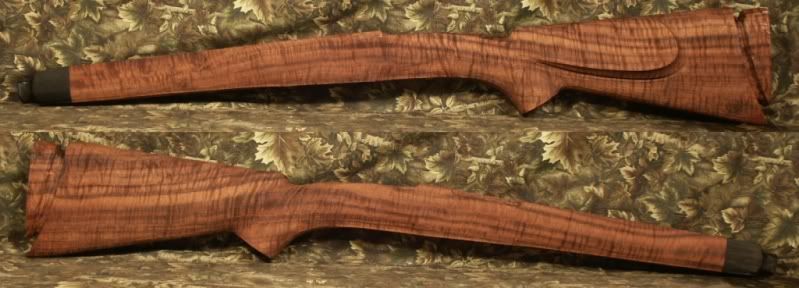 Thanks. Jim "Life's hard; it's harder if you're stupid" John Wayne | |||
|
| One of Us |
I believe fiddleback is more difficult to split...also more difficult to inlet! | |||
|
One of Us |
Ok, I’m getting a better handle on this. 1) 1st blank is a go if stock layout can be positioned to allow grain to run though/down the grip rather than cut across the grip. 2) 2nd blank is a no go due to size of blank and grain flow through grip area. and, 3) The GAGC (corrected the name, wasn’t wearing my reading glasses earlier) possesses the correct grain flow from toe through grip though forearm but is an inletting pita due to fiddleback which also inhibits stock splitting. But…oops (again didn’t have glasses on) it is a black walnut which you all most likely knew anyway rather than English walnut so may not be as strong of a stock even with the fiddleback. Boy I should’ve purchased those two Australian Walnut blanks a couple of years ago...looked a little plain but really great grain structure in both blanks! Ok…any other recommendations of what to look for or perhaps better yet what to stay away from? And thanks again for your comments! Jim "Life's hard; it's harder if you're stupid" John Wayne | |||
|
| One of Us |
I would use the bottom one, if I had to use one of these. The grain flow in the third image is much more preferable than either of the raw blanks though. The top blank, at least in the photos, looks to be mostly sap wood, the heartwood is only going to show in a small part of the finished stock. It looks to be more porous also. I'd bet that the bottom blank is denser. It is mostly heartwood. Whilst it is the better of the two, I would prefer to see the grain flow following the curve of the grip more for better strength. Make sure the splitting grain is running fairly straight from the top/bottom view too, especially through the grip and action inlet. You really need to physically check the quality of the wood too, it may be brittle and chippy, or tough leathery wood which is what you need. The bottom blank looks to be a bit sappy in the toe area too, this will probably only affect the appearance. Personally I would keep looking, but them I am spoilt for good wood. Yes alot can be done to toughen a blank up for heavy calibres but you are miles in front starting with an ideal blank to begin with. Much of the sapwood you will encounter is white in colour, but some trees naturally have a honey coloured sapwood. If the flitches or wet blanks are steamed, or the log left for a time before milling, it can darken the sapwood up and can make it harder to tell what is what. I am always wary of steamed blanks.......... I strongly believe the quality of the wood is affected in a negative way (opens pores and more chippy), and the colours seem washed out. | |||
|
| one of us |
I'd pass on both of these. There are blanks where the grain is too straight. This is just the case with both of these blanks. There's no flow through the wrist (grip area) and the toe looks very weak. I like the color and streaks in both blanks but I'd keep looking. ______________________________ "Truth is the daughter of time." Francis Bacon | |||
|
| One of Us |
Both are technically too straight. But, from the pics you show, the lower blank is, IMO, the better of the two. Assuming that the grain is straight on top and bottom, I would have no problem using it for a .500. When laying out a blank with this straight grain flow you can improve it a bit by going as low as possible with the forend and as high as possible at the butt. The use of a 1" decelerator pad goes a long way in strengthening the 'weak toe' of this type of lay-out. I would actually use this lay-out long before using the excessive down curve in the butt that I see on so many rifles these days. I've seen several of that type broken off right behind the grip. Yet, the only broken 'toes' that I've seen were on rifles with steel or plastic buttplates. Ideally, all custom stocks would have a lay-out similar to the pre-carved stock you've pictured. | |||
|
| Moderator |
not for nothing, but I've built .550 stocks on turkish blanks that are not much different than this one  *I* like guitar strings in mine opinions vary band of bubbas and STC hunting Club Information on Ammoguide about the416AR, 458AR, 470AR, 500AR What is an AR round? Case Drawings 416-458-470AR and 500AR. 476AR, http://www.weaponsmith.com | |||
|
| Powered by Social Strata |
| Please Wait. Your request is being processed... |
|

Visit our on-line store for AR Memorabilia

